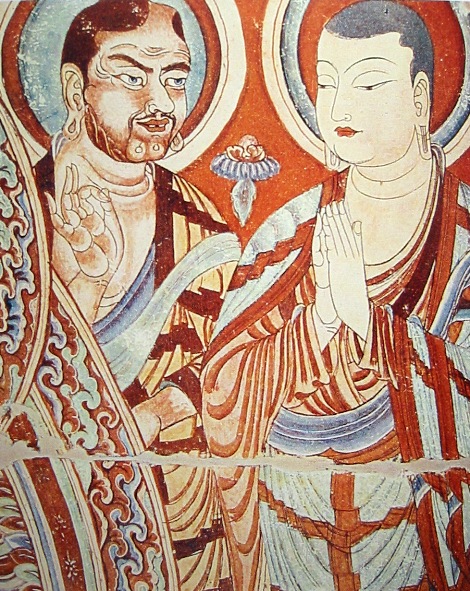
A Caucasian Central Asian monk, possibly an Indo-European Sogdian or Tocharian, teaching an East Asian monk, perhaps a Turkic Uyghur or Chinese, on a 9th-century AD fresco from the Bezeklik Thousand Buddha Caves near Turfan, Xinjiang, China. A detail from Praņidhi scene no. 5 in Temple no. 9. The book that this painting is reproduced in has full descriptions of these two figures. Relevant details, along with the German descriptions, are found below. The figure on the right is a young Buddhist monk painted in a stereotypical East Asian style. He stands with downcast eyes directed in reverence as he hears the teachings of the figure on the left. The figure on the left is painted in a style that is not East Asian in character. The two circles on either side of his chin are remarkably unusual (piercings?). He features a strongly-set nose and clear blue eyes. His skin color is darker. His hair and beard color is reddish brown with brown shades. He stands looking at the younger monk, raising his hand in a teaching gesture as he speaks.

The Sogdian city-states, although never politically united, were centered on the city of Samarkand. Sogdian, an Eastern Iranian language, is no longer spoken, but a descendant of one of its dialects, Yaghnobi, is still spoken by the Yaghnobis of Tajikistan. It was widely spoken in Central Asia as a lingua franca and served as one of the First Turkic Khaganate's court languages for writing documents.
Sogdians also lived in Imperial China and rose to prominence in the military and government of the Chinese Tang dynasty (618–907 AD).

The first documented translation efforts by Buddhist monks in China were in the 2nd century CE via the Kushan Empire into the Chinese territory bordering the Tarim Basin under Kanishka.[7][8] These contacts transmitted strands of Sarvastivadan and Tamrashatiya Buddhism throughout the Eastern world.[9]
Agricultural communities first appeared in the oases of the northern Tarim circa 2,000 BC. Some scholars have linked these communities to the Afanasievo culture found earlier (c. 3,500–2,500 BC) in Siberia, north of the Tarim or Central Asian BMAC culture. The earliest Tarim mummies date from c. 1,800 BC, but it is unclear whether they are connected to the Tocharians of two millennia later.
By the 2nd century BC, these settlements had developed into city-states, overshadowed by nomadic peoples to the north and Chinese empires to the east. These cities, the largest of which was Kucha, also served as way stations on the branch of the Silk Road that ran along the northern edge of the Taklamakan desert.
For several centuries, the Tarim basin was ruled by the Xiongnu, the Han dynasty, the Tibetan Empire, and the Tang dynasty. From the 8th century AD, the Uyghurs – speakers of a Turkic language – settled in the region and founded the Kingdom of Qocho that ruled the Tarim Basin. The peoples of the Tarim city-states intermixed with the Uyghurs, whose Old Uyghur language spread through the region. The Tocharian languages are believed to have become extinct during the 9th century.
https://education.asianart.org/resources/buddhism-in-the-tang-618-906-and-song-960-1279-dynasties/
Buddhism was severely persecuted in 845 and again in the 900s during the Five Dynasties period between the Tang and the Song. Many of the reasons for this suppression were economic. Thousands of temples were destroyed and metal objects melted down for hard currency. Many monks and nuns were forced to return to lay life, where they could contribute to the general tax base.
Despite these persecutions and continuing difficulties accommodating itself on foreign soil, Buddhism for most part thrived among the Chinese population, in particular during the Song when it moved out of the realm of official state sponsorship and into the mainstream of popular religion.
In the artistic realm, Buddhism not only contributed to the development of sculpture during the Tang and Song period, it furthered the development of printed books and religious architecture in China. Scholar John Kieschnick has suggested that the unique combination of Buddhism and Chinese culture also helped further develop the use of the chair, and the popularization of tea in China during this time.
The predominant forms of Buddhism in China were drawn from Mahayana Buddhism, a branch of Buddhism that espoused the possibility of enlightenment for all sentient beings, with the help of bodhisattvas, compassionate, enlightened beings who had postponed their own entry into nirvana in order to help others along the path to enlightenment. These bodhisattvas would become increasingly important figures in Chinese Buddhist arts as time progressed. The main forms of Buddhism present in China during the Tang and Song period (some unique to China) included:
- Tiantai (“heavenly terrace”) Buddhism: A school of Buddhism that aimed to synthesize various existing Buddhist practices; its principle text was the “Sutra of the Lotus of the True Law” (the “Lotus Sutra”—one of the most popular Buddhist texts during the Tang-Song period); it appealed mainly to the literate, ruling classes.
- Avatamsaka (Huayan, “flower garland”) Buddhism: After text of the same name; followed concept of two worlds, li (ultimate principle) and shi (phenomena); this school was supported by Empress Wu of the Tang.

No comments:
Post a Comment